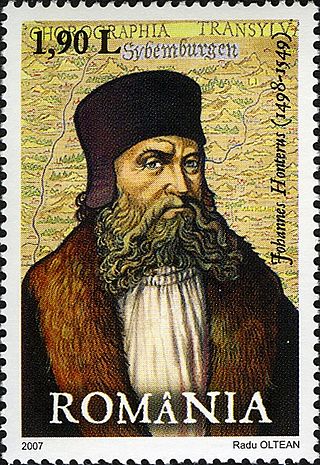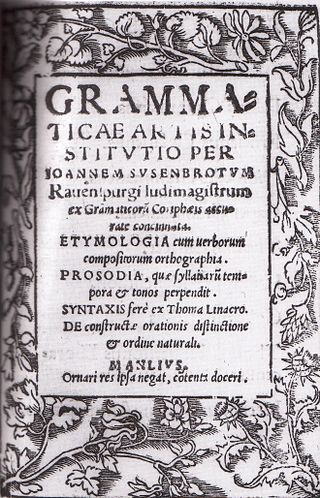Related Research Articles

Ludwig Alois Friedrich Ritter von Köchel was an Austrian musicologist, writer, composer, botanist, and publisher. He is best known for cataloguing the works of Mozart and originating the 'KV-numbers' by which they are known.

Rodolphus Agricola was a Dutch humanist of the Northern Low Countries, famous for his knowledge of Latin and Greek. He was an educator, musician, builder of church organs, a poet in Latin and the vernacular, a diplomat, a boxer and a Hebrew scholar towards the end of his life. Today, he is best known as the author of De inventione dialectica, the father of Northern European humanism and as a zealous anti-scholastic in the late fifteenth century.

Johannes Müller von Königsberg, better known as Regiomontanus, was a mathematician, astrologer and astronomer of the German Renaissance, active in Vienna, Buda and Nuremberg. His contributions were instrumental in the development of Copernican heliocentrism in the decades following his death.

Theodor Zwinger the Elder was a Swiss physician and Renaissance humanist scholar. He made significant contributions to the emerging genres of reference and travel literature. He was the first distinguished representative of a prominent Basel academic family.

Conrad Celtes was a German Renaissance humanist scholar and poet of the German Renaissance born in Franconia. He led the theatrical performances at the Viennese court and reformed the syllabi.

Ulrich von Hutten was a German knight, scholar, poet and satirist, who later became a follower of Martin Luther and a Protestant reformer.

Johannes Honter was a Transylvanian Saxon, renaissance humanist, Protestant reformer, and theologian. Honter is best known for his geographic and cartographic publishing activity, as well as for implementing the Lutheran reform in Transylvania and founding the church, which would become the Evangelical Church of the Augsburg Confession in Romania, after Romania annexed Transylvania.

Joannes Susenbrotus was a German humanist, teacher of Latin, and author of textbooks.

The German Renaissance, part of the Northern Renaissance, was a cultural and artistic movement that spread among German thinkers in the 15th and 16th centuries, which developed from the Italian Renaissance. Many areas of the arts and sciences were influenced, notably by the spread of Renaissance humanism to the various German states and principalities. There were many advances made in the fields of architecture, the arts, and the sciences. Germany produced two developments that were to dominate the 16th century all over Europe: printing and the Protestant Reformation.

During the Renaissance, great advances occurred in geography, astronomy, chemistry, physics, mathematics, manufacturing, anatomy and engineering. The collection of ancient scientific texts began in earnest at the start of the 15th century and continued up to the Fall of Constantinople in 1453, and the invention of printing allowed a faster propagation of new ideas. Nevertheless, some have seen the Renaissance, at least in its initial period, as one of scientific backwardness. Historians like George Sarton and Lynn Thorndike criticized how the Renaissance affected science, arguing that progress was slowed for some amount of time. Humanists favored human-centered subjects like politics and history over study of natural philosophy or applied mathematics. More recently, however, scholars have acknowledged the positive influence of the Renaissance on mathematics and science, pointing to factors like the rediscovery of lost or obscure texts and the increased emphasis on the study of language and the correct reading of texts.

Johannes Stabius (1450–1522) was an Austrian cartographer and astronomer of Vienna who developed, around 1500, the heart-shape (cordiform) projection map later developed further by Johannes Werner. It is called the Werner map projection, but also the Stabius-Werner or the Stab-Werner projection.

Achilles Pirmin Gasser was a German physician and astrologer. He is now known as a well-connected humanistic scholar, and supporter of both Copernicus and Rheticus.
Giovanni Aurelio Augurello (1441–1524) was an Italian humanist scholar, poet and alchemist. Born at Rimini, he studied both laws in Rome, Florence and Padova where he also consorted with the leading scholars of his time. At Florence he befriended Marsilio Ficino (1433-1499) and Angelo Poliziano (1454-1494) and later while teaching classics in Treviso joined Aldo Mantius' humanist circle in Venice. Apart from his academic and literary work he practically experimented in metallurgy and provided colour pigments for his friend the Hermetic painter Giulio Campagnola He is best known for his 1515 allegorical poem on the making of gold, Chrysopoeia, which was dedicated to Pope Leo X; leading to the famous but forged anecdote that the Pope had rewarded Augurello with a beautiful but empty purse as an alchemist like him should on his own to be capable of replenishing it — he was actually bestowed with a sinecure at the cathedral of Treviso.
Johannes von Gmunden was a German/Austrian astronomer, mathematician, humanist and early instrument maker.

János Zsámboky or János Zsámboki or János Sámboki, was a Hungarian humanist scholar: physician, philologist and historian.
Hardwin von Grätz, better known in English as Ortwin, was a German humanist scholar and theologian. Ortwin was born in Holtwick and died in Cologne, Germany. He was raised by his uncle, Johannes von Grätz, in Deventer. In 1501 he left to pursue philosophical studies at the University of Cologne. After joining Kyuk Burse, Ortwin became licensed in 1505, attained Masters level in 1506, and became an Art Professor in 1507. He supplemented his salary by proofing documents for the Quentell printing house and wrote introductions and poetic dedications in the volumes of classical authors of the Middle Ages.
Johannes Murmellius was a Dutch teacher and humanist, known for numerous textbooks, and his spreading of humanism, particularly in the Prince-Bishopric of Münster.

Nikolaus Gerbel was a German humanist, jurist and doctor of both laws.

Humanist minuscule is a handwriting or style of script that was invented in secular circles in Italy, at the beginning of the fifteenth century. "Few periods in Western history have produced writing of such great beauty", observes the art historian Millard Meiss. The new hand was based on Carolingian minuscule, which Renaissance humanists, obsessed with the revival of antiquity and their role as its inheritors, took to be ancient Roman:
[W]hen they handled manuscript books copied by eleventh- and twelfth-century scribes, Quattrocento literati thought they were looking at texts that came right out of the bookshops of ancient Rome".
Conrad Goclenius was a Renaissance humanist, and Latin scholar, and the closest confidant of humanist Desiderius Erasmus, who was born in Mengeringhausen in the Landgraviate of Hesse in 1490, and died in Leuven on January 25, 1539.